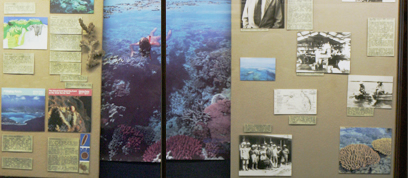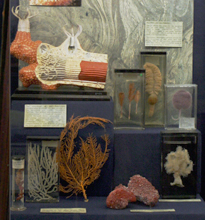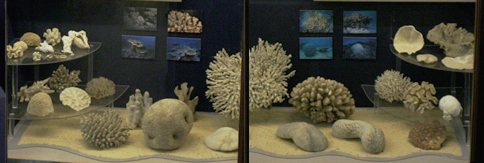
PHYLUM CNIDARIA
This phylum of 9000 species includes some of the most beautiful and abundant marine animals assigned to three classes: Class Hydrozoa, Class Scyphozoa, Class Anthozoa..
Although outwardly very different in form, both flower-like polyps and free swimming medusae (jelly fish) share a simple radially symmetrical body plan with tentacles. In many species polyps and medusae follow one another as stages in the life cycle.
The great diversity in form is due to the tendency of polyps to grow as colonies. Some colonies have one type of polyp; others are polymorphic, being composed of polyps of differing structure and function.
Cnidarians are diploblastic animals: their three-layered bodies are constructed from only two germ layers. The epidermis is formed from the endoderm, the cells lining the gastrovascular cavity from the endoderm. The middle layer, the mesogloea, may be a thin non-cellular membrane or a thick gelatinous layer.
Cnidarians are carnivorous – feeding on zooplankton, crustacea or small fish. They trap their food in their tentacles, which are armed with unique cells – cnidocytes – containing coiled stinging threads. When food or an enemy approaches, the threads armed with spines like a harpoon and often loaded with poison are discharged. The prey is trapped in the tentacles, paralysed and passed to the mouth. Their enemies include sea-slugs which ingest and retain the cnidocytes in pockets of their digestive tracts. When another animal attacks the sea slug, the cnidocytes discharge and help to protect their new owner.
Cnidarians may exhibit an ‘alternation of generations’. When both polyps and medusae exist within a Cnidarian life cycle, polyps reproduce asexually by budding off medusae. Medusae give rise to polyps by sexual reproduction. This type of life cycle gives rise to an Alternation of Generations in the Class Hydrozoa where polyps are the dominant form and in the Class Scyphozoa where the medusoid form dominates. The class Anthozoa exists only as polyps reproducing both asexually and sexually and does not exhibit an alternation of generations.
|
||||||||||||||||||||||||||||||||||||||||||||||||||||||||||||||||
















